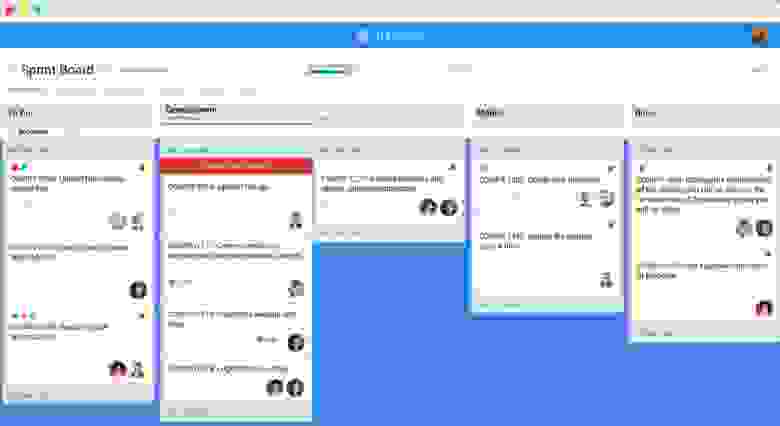In any business, it’s not a good practice to constantly switch from one methodology to another. Most software development teams prefer to work with one-defined project management method. However, there are lots of companies who try to combine the best features and practices of different methods to create their own unique approach.
In this post, you will learn some basic facts about Scrumban and how to combine two popular Agile methodologies – Kanban and Scrum to make this hybrid approach perform better.

But first, it worth to recollect some fundamental facts about both Agile methods. What is your favorite in the fight Scrum vs Kanban?
Scrum was originally designed to help teams maximize their ability to deliver quickly, respond to emerging requirements, and adapt to changes in market conditions.
This Agile framework requires using fixed-length development cycles called sprints. Each sprint usually lasts 1-4 weeks.
A Scrum team is usually small, self-organized and cross-functional. Team members split work into small product increments and prioritize tasks. The product owner chooses all work to be done in a sprint at one time. Then the team completes the work during each sprint.
Scrum helps to achieve agility. It implicates frequent feedback and collaborative decision-making principles.
Kanban is a visual workflow management approach for managing the creation of products with an emphasis on continual delivery without teams overburdening. The method has come form manufacturing.
All work items in Kanban are visualized with cards on a board and lanes that represent process stages. A Kanban board is used to manage the collective work of the team.
Kanban-focused teams practice a continuous flow approach (continuously planning, working, reviewing, and measuring the results).
One of the essential Kanban tools is WIP limits. It helps to minimize chaos and promote focus by explicitly limiting how many items are in process. Kanban teams measure lead time — the average time from when work is requested to when it is finished.
One of the aspects of Scrum and Kanban success is that development teams direct their own work, guided by the business goals. Both approaches advocate respect for people and allow them to do their best work.
Both methods prosper from well-defined user stories that can be accomplished and delivered separately. Scrum leaves the decision about how much to work at the same time to the team. Kanban focuses on limiting the number of items the team has in progress. The main difference is that Scrum measures the levels of teams’ productivity in terms of the team’s speed, Kanban controls for continuous work in progress and limits the number of stories the team will accept to working on at the same time.
A Kanban board is split into columns and Swimlanes. Every column represents a stage of the workflow. Swimlanes help to separate different types of activities. A typical Kanban board is split into 3 sections that show the state of your tasks: To Do, In Progress and Done.
The WIP limits feature in Kanban lets you provide more time to the people who are responsible for this stage and allow them to resolve the bottleneck.
A Scrum board is also made up of horizontal (and often vertical) Swimlanes that track the progress of tasks and stories committed to during a Sprint. The typical Scrum board consists of several progressive columns: Stories, To Do, In Progress, Testing and Done. Team members are able to move their work items along the board.
The decision about the best methodology should be well-balanced. Many specialists think that you will find Scrum the most obvious choice if you are creating products, and Kanban will suit better if you provide services. However, there is an option to combine them. This solution is Scrumban.
Scrumban is a hybrid Agile development methodology that combines the best practices of Scrum and Kanban. The method was created to meet team needs concerning minimizing the batching of work and adopting a pull-based system.
Scrumban method was introduced by a software development enthusiast, Corey Ladas. In his book, Scrumban: Essays on Kanban Systems for Lean Software Development, he claims that Scrumban is aimed to transition a development team from Scrum to Lean or Kanban. Over time, this became an independent methodology.
The hybrid of two popular Agile methodologies provides development teams with the flexibility to adapt and change to stakeholders and production requirements without overburdens.
Scrumban is a highly versatile approach to workflow management because it provides the structure of Scrum with the visualization and flexibility of Kanban.
Some teams utilize Scrumban as a stepping stone to move from Scrum to Kanban. It makes sense, as the immediate shift to Kanban may be too painful and drastic for many software development teams.

The main objective of Scrumban is to provide teams a soft and healthy way of learning how to practice Continuous Improvement in Kanban without leaving the familiar Scrum structure.
As the hybrid approach combines the Scrum structure with the flow-based methods of Kanban, it's important to understand what exactly did it take from each system.
Kanban improves visualization, adds process improvement, and provides more value metrics to Scrumban. Here are Kanban elements that are used by Scrumban teams:
The right way to pull off Scrumban is to apply a modern project management software that is suited for both Scrum and Kanban development.
If this project management tool provides convenient boards and cards, WIP limits, Swimlanes, Lead and Cycle Time, then it can be easily applied to your Scrumban software development.

Despite a large number of opponents of mergers and acquisitions, the combination of two Agile methodologies has passed the test of time. The hybrid approach has proven its usefulness and convenience and has demonstrated real strength.
Kanban is compatible with Scrum. Adding WIP limits, visualization and other elements to Scrum helps to improve Sprint Commitment effectiveness.
However, it also introduces the WIP limit as a mechanism to catalyze incremental changes. The WIP limit obviates the need for commitment to drive change, reduces any dysfunctional reliance on heroic effort, and improves overall systems thinking when considering potential improvements.
After all, let's define Scrumban as a soft evolution rather than shock treatment. What do you think about it? Have you tried to combine both Agile methodologies? Was this mix effective? Feel free to share your experience below.
In this post, you will learn some basic facts about Scrumban and how to combine two popular Agile methodologies – Kanban and Scrum to make this hybrid approach perform better.

But first, it worth to recollect some fundamental facts about both Agile methods. What is your favorite in the fight Scrum vs Kanban?
Scrum 101
Scrum was originally designed to help teams maximize their ability to deliver quickly, respond to emerging requirements, and adapt to changes in market conditions.
This Agile framework requires using fixed-length development cycles called sprints. Each sprint usually lasts 1-4 weeks.
A Scrum team is usually small, self-organized and cross-functional. Team members split work into small product increments and prioritize tasks. The product owner chooses all work to be done in a sprint at one time. Then the team completes the work during each sprint.
Scrum helps to achieve agility. It implicates frequent feedback and collaborative decision-making principles.
Kanban 101
Kanban is a visual workflow management approach for managing the creation of products with an emphasis on continual delivery without teams overburdening. The method has come form manufacturing.
All work items in Kanban are visualized with cards on a board and lanes that represent process stages. A Kanban board is used to manage the collective work of the team.
Kanban-focused teams practice a continuous flow approach (continuously planning, working, reviewing, and measuring the results).
One of the essential Kanban tools is WIP limits. It helps to minimize chaos and promote focus by explicitly limiting how many items are in process. Kanban teams measure lead time — the average time from when work is requested to when it is finished.
Common features in Scrum and Kanban
Self-managed teams
One of the aspects of Scrum and Kanban success is that development teams direct their own work, guided by the business goals. Both approaches advocate respect for people and allow them to do their best work.
Work packages
Both methods prosper from well-defined user stories that can be accomplished and delivered separately. Scrum leaves the decision about how much to work at the same time to the team. Kanban focuses on limiting the number of items the team has in progress. The main difference is that Scrum measures the levels of teams’ productivity in terms of the team’s speed, Kanban controls for continuous work in progress and limits the number of stories the team will accept to working on at the same time.
Boards structure
A Kanban board is split into columns and Swimlanes. Every column represents a stage of the workflow. Swimlanes help to separate different types of activities. A typical Kanban board is split into 3 sections that show the state of your tasks: To Do, In Progress and Done.
The WIP limits feature in Kanban lets you provide more time to the people who are responsible for this stage and allow them to resolve the bottleneck.
A Scrum board is also made up of horizontal (and often vertical) Swimlanes that track the progress of tasks and stories committed to during a Sprint. The typical Scrum board consists of several progressive columns: Stories, To Do, In Progress, Testing and Done. Team members are able to move their work items along the board.
Combining the best practices of both Agile worlds
The decision about the best methodology should be well-balanced. Many specialists think that you will find Scrum the most obvious choice if you are creating products, and Kanban will suit better if you provide services. However, there is an option to combine them. This solution is Scrumban.
Scrumban definition
Scrumban is a hybrid Agile development methodology that combines the best practices of Scrum and Kanban. The method was created to meet team needs concerning minimizing the batching of work and adopting a pull-based system.
Scrumban method was introduced by a software development enthusiast, Corey Ladas. In his book, Scrumban: Essays on Kanban Systems for Lean Software Development, he claims that Scrumban is aimed to transition a development team from Scrum to Lean or Kanban. Over time, this became an independent methodology.
Scrum + Kanban = Scrumban
The hybrid of two popular Agile methodologies provides development teams with the flexibility to adapt and change to stakeholders and production requirements without overburdens.
Scrumban is a highly versatile approach to workflow management because it provides the structure of Scrum with the visualization and flexibility of Kanban.
Some teams utilize Scrumban as a stepping stone to move from Scrum to Kanban. It makes sense, as the immediate shift to Kanban may be too painful and drastic for many software development teams.

The main objective of Scrumban is to provide teams a soft and healthy way of learning how to practice Continuous Improvement in Kanban without leaving the familiar Scrum structure.
As the hybrid approach combines the Scrum structure with the flow-based methods of Kanban, it's important to understand what exactly did it take from each system.
What Scrum elements are incorporated into Scrumban?
- Iteration planning at regular intervals that is in sync with reviews and retrospectives.
- Work prioritization that gives teams the best thing to work on next
- The decision about how much work can be pulled into the sprint according to the complexity of the work and the length of the sprint.
- The assurance of the necessary level of analysis before development
- Using the ready queue between Backlog and Doing phases
What Kanban elements are incorporated into Scrumban?
Kanban improves visualization, adds process improvement, and provides more value metrics to Scrumban. Here are Kanban elements that are used by Scrumban teams:
- Continuous workflow and Pull System.
- WIP limits — the explicit limits on how many items are in progress.
- Focusing more on Cycle time than Burndown
- Not clearly specified individual roles
- Short lead times with emphasizing just-in-time analysis and planning.
- Using flow diagrams to expose process weaknesses and identify opportunities for improvement.
Quick set of Scrumban advantages
- High quality
- Short lead time
- Fact and decisions just when they are needed (Just-in-time)
- Continuous improvement (Kaizen)
- Minimizing everything that is not adding value to customers
- Process improvement by adding some Scrum values if needed
- Perfect visualization of a Scrumban board
Scrumban software
The right way to pull off Scrumban is to apply a modern project management software that is suited for both Scrum and Kanban development.
If this project management tool provides convenient boards and cards, WIP limits, Swimlanes, Lead and Cycle Time, then it can be easily applied to your Scrumban software development.

Summary
Despite a large number of opponents of mergers and acquisitions, the combination of two Agile methodologies has passed the test of time. The hybrid approach has proven its usefulness and convenience and has demonstrated real strength.
Kanban is compatible with Scrum. Adding WIP limits, visualization and other elements to Scrum helps to improve Sprint Commitment effectiveness.
However, it also introduces the WIP limit as a mechanism to catalyze incremental changes. The WIP limit obviates the need for commitment to drive change, reduces any dysfunctional reliance on heroic effort, and improves overall systems thinking when considering potential improvements.
After all, let's define Scrumban as a soft evolution rather than shock treatment. What do you think about it? Have you tried to combine both Agile methodologies? Was this mix effective? Feel free to share your experience below.